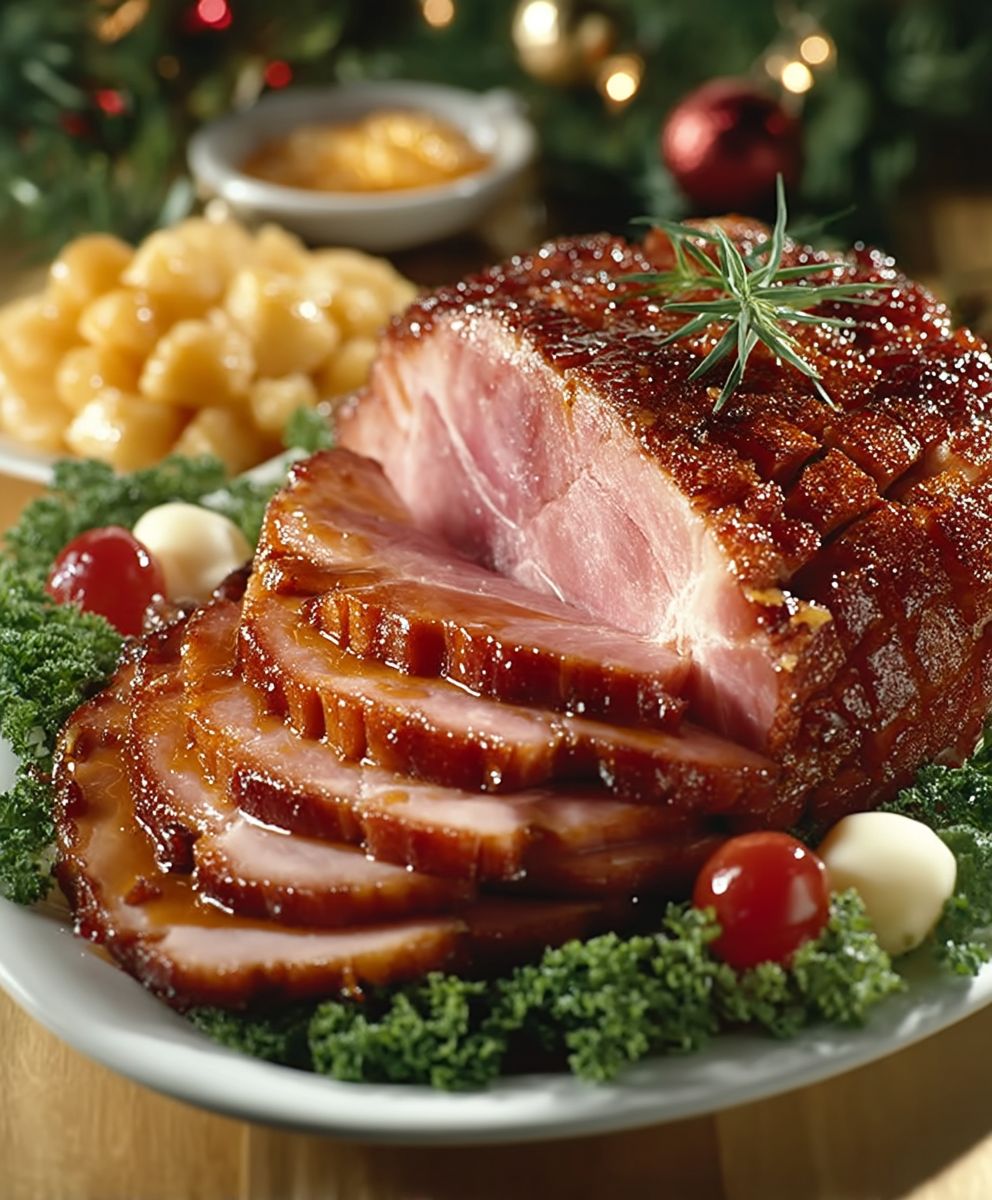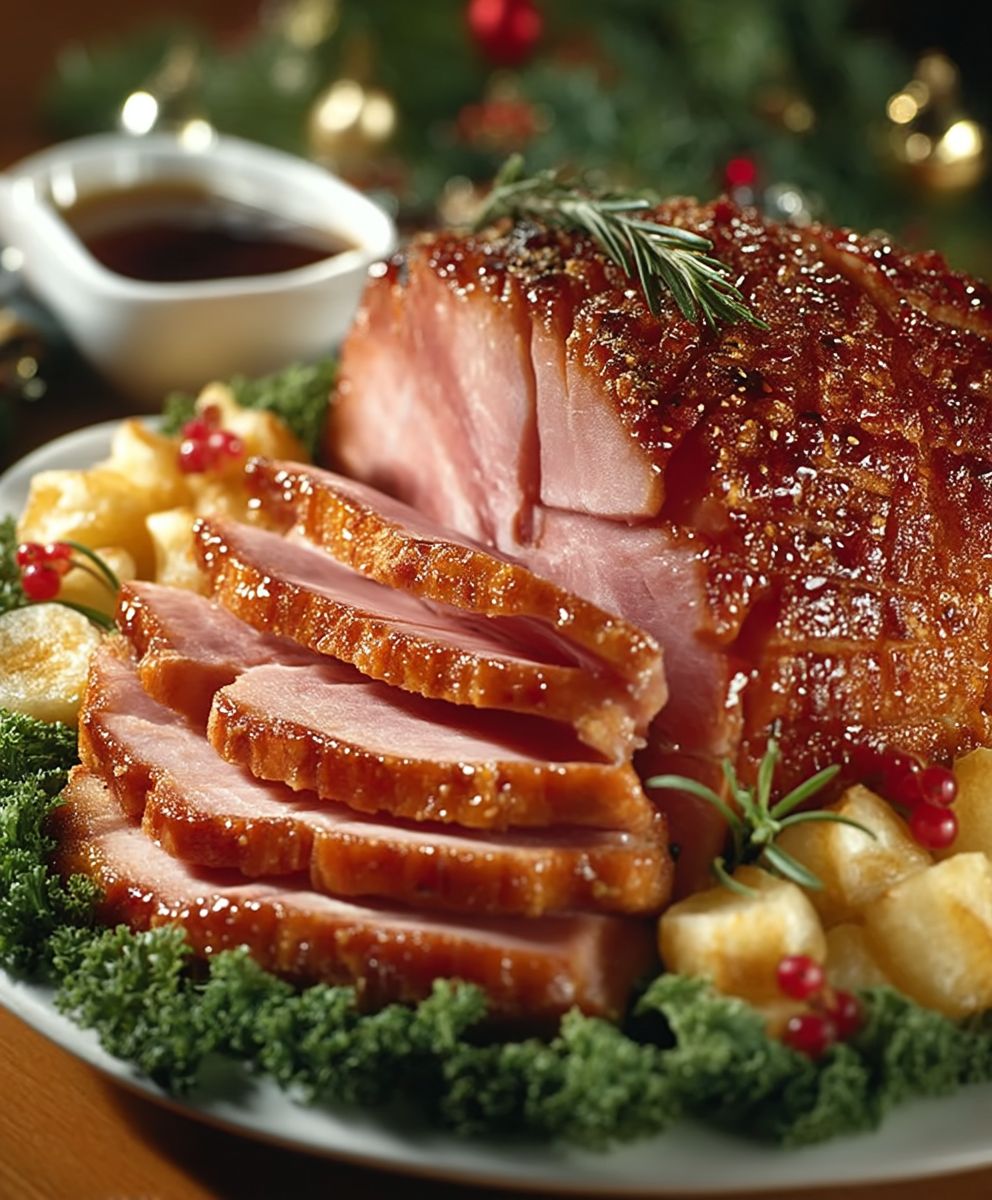Apricot Glazed Ham, a centerpiece of holiday feasts and celebratory gatherings, is more than just a meal; it’s a tradition steeped in history and bursting with flavor. Have you ever wondered how to elevate a classic ham from simply delicious to utterly unforgettable? I’m here to tell you, the secret lies in the glaze, and this apricot glaze is about to become your new favorite.
The practice of glazing hams dates back centuries, with early methods involving honey and spices to preserve and enhance the meat. Over time, fruit glazes, like our star apricot, emerged as a delightful way to add sweetness and a touch of acidity to balance the ham’s richness. Apricots, with their vibrant color and subtly tart flavor, bring a unique dimension to this classic dish.
People adore Apricot Glazed Ham for its perfect harmony of sweet and savory. The tender, juicy ham, infused with the bright, fruity notes of apricot, creates a truly irresistible combination. The glaze itself caramelizes beautifully during baking, creating a stunning presentation and a delightful textural contrast. Plus, it’s surprisingly easy to prepare, making it a fantastic option for both seasoned cooks and kitchen novices alike. Get ready to impress your guests with this show-stopping dish!
Ingredients:
- 1 (10-12 pound) fully cooked, bone-in ham
- 1/2 cup whole cloves
- For the Apricot Glaze:
- 1 cup apricot preserves
- 1/4 cup Dijon mustard
- 1/4 cup honey
- 2 tablespoons apple cider vinegar
- 1 tablespoon Worcestershire sauce
- 1 teaspoon ground ginger
- 1/2 teaspoon garlic powder
- 1/4 teaspoon red pepper flakes (optional, for a little kick)
- 1/4 cup water (if needed, to thin the glaze)
Preparing the Ham:
- Preheat your oven to 325°F (160°C). This is crucial for even heating and preventing the ham from drying out. Make sure your oven rack is positioned in the lower third of the oven to accommodate the ham.
- Prepare the ham for scoring. Remove the ham from its packaging and discard any netting or plastic discs. Place the ham on a large cutting board.
- Score the ham. Using a sharp knife, score the ham in a diamond pattern. Make cuts about 1/4 to 1/2 inch deep and spaced about 1 inch apart. This allows the glaze to penetrate the ham and creates a beautiful presentation. Be careful not to cut too deeply, you just want to score the surface.
- Insert the cloves. Stud the ham with whole cloves, placing one clove at each intersection of the diamond pattern. This adds a wonderful aroma and flavor to the ham. Don’t be shy with the cloves; they really enhance the overall taste.
- Place the ham in a roasting pan. Transfer the ham to a large roasting pan. A roasting pan with a rack is ideal, as it allows the ham to cook evenly and prevents it from sitting in its own juices. If you don’t have a rack, you can use a bed of chopped vegetables like carrots, celery, and onions to elevate the ham.
- Add water to the pan (optional). Pour about 1 cup of water into the bottom of the roasting pan. This helps to create steam and keeps the ham moist during cooking. Be sure to check the water level periodically and add more if it evaporates.
Making the Apricot Glaze:
- Combine the glaze ingredients. In a medium saucepan, combine the apricot preserves, Dijon mustard, honey, apple cider vinegar, Worcestershire sauce, ground ginger, garlic powder, and red pepper flakes (if using).
- Heat the glaze. Place the saucepan over medium heat and bring the mixture to a simmer, stirring constantly.
- Simmer and thicken. Reduce the heat to low and simmer for about 5-7 minutes, or until the glaze has thickened slightly. Stir occasionally to prevent sticking.
- Adjust the consistency (if needed). If the glaze is too thick, add a tablespoon of water at a time until it reaches your desired consistency. It should be thick enough to coat the ham but still pourable.
- Taste and adjust seasonings. Give the glaze a taste and adjust the seasonings as needed. You might want to add a pinch more ginger, a dash more vinegar, or a little more honey depending on your preference.
Baking and Glazing the Ham:
- Bake the ham. Cover the roasting pan tightly with aluminum foil. This helps to trap moisture and prevent the ham from drying out. Bake the ham for about 10-12 minutes per pound, or until the internal temperature reaches 140°F (60°C). Use a meat thermometer to ensure accuracy.
- Baste with glaze (first time). Remove the ham from the oven and carefully remove the aluminum foil. Brush about half of the apricot glaze evenly over the ham, making sure to get into all the crevices created by the scoring.
- Return to oven (uncovered). Return the ham to the oven, uncovered, and continue baking for another 15-20 minutes.
- Baste with glaze (second time). Remove the ham from the oven again and brush with the remaining apricot glaze.
- Final bake. Return the ham to the oven for a final 10-15 minutes, or until the glaze is bubbly and caramelized and the internal temperature reaches 145°F (63°C). Watch carefully to prevent the glaze from burning.
- Rest the ham. Remove the ham from the oven and let it rest for at least 15-20 minutes before carving. This allows the juices to redistribute, resulting in a more tender and flavorful ham. Tent the ham loosely with aluminum foil during the resting period to keep it warm.
Carving and Serving:
- Carve the ham. Place the ham on a large cutting board. Using a sharp carving knife, begin by slicing around the bone to separate the meat. Then, slice the ham into thin, even slices.
- Serve and enjoy! Arrange the ham slices on a platter and serve immediately. The apricot glaze will have created a beautiful, glossy finish and a delicious flavor.
Tips for Success:
- Choosing the right ham: Opt for a high-quality, fully cooked, bone-in ham for the best flavor and texture. A spiral-cut ham can also be used, but be careful not to overcook it, as it tends to dry out more easily.
- Preventing dryness: To prevent the ham from drying out, be sure to cover it with aluminum foil during the initial baking period and add water to the bottom of the roasting pan. Basting with the glaze also helps to keep the ham moist.
- Glaze variations: Feel free to experiment with different glaze variations. You can add other fruits like pineapple or orange, or use different spices like cinnamon or cloves.
- Leftovers: Leftover ham can be stored in the refrigerator for up to 5 days. It can be used in sandwiches, salads, soups, or casseroles.
- Make ahead: The apricot glaze can be made ahead of time and stored in the refrigerator for up to 3 days. Simply reheat it before using.
Serving Suggestions:
- Serve the apricot glazed ham with classic sides like mashed potatoes, green beans, and dinner rolls.
- A fruit salad or cranberry sauce also complements the ham nicely.
- For a more elegant presentation, garnish the ham with fresh herbs like rosemary or thyme.
Troubleshooting:
- Glaze is too thick: Add a tablespoon of water at a time until it reaches your desired consistency.
- Glaze is burning: Reduce the oven temperature or cover the ham loosely with aluminum foil.
- Ham is drying out: Make sure to cover the ham with aluminum foil during the initial baking period and add water to the bottom of the roasting pan. Baste the ham frequently with the glaze.
- Ham is not heating evenly: Rotate the roasting pan halfway through the baking time.
Nutritional Information (approximate, per serving):
- Calories: 350
- Protein: 30g
- Fat: 15g
- Carbohydrates: 20g
Enjoy your delicious Apricot Glazed Ham!

Conclusion:
This isn’t just another ham recipe; it’s a culinary experience waiting to happen. The sweet and tangy Apricot Glazed Ham is a showstopper, guaranteed to be the star of your next holiday gathering or Sunday supper. The combination of savory ham, infused with the bright, fruity notes of apricot, creates a flavor profile that’s both comforting and exciting. Trust me, the aroma alone will have your guests clamoring for a slice!
But what truly sets this recipe apart is its simplicity. You don’t need to be a seasoned chef to achieve ham perfection. The glaze comes together quickly with just a handful of ingredients, and the baking process is straightforward, allowing you to focus on other aspects of your meal preparation. I’ve made this ham countless times, and it always delivers consistent, delicious results.
Beyond the incredible flavor and ease of preparation, this Apricot Glazed Ham is incredibly versatile. Serve it warm, straight from the oven, as the centerpiece of your holiday feast, accompanied by classic sides like scalloped potatoes, green bean casserole, and cranberry sauce. Or, let it cool and slice it thinly for sandwiches, salads, or even a delicious ham and cheese quiche. The possibilities are endless!
Looking for some variations? Consider adding a touch of Dijon mustard to the glaze for a subtle kick. A sprinkle of chopped fresh rosemary or thyme before baking will also elevate the flavor profile. For a spicier twist, incorporate a pinch of red pepper flakes into the glaze. And if you’re feeling adventurous, try using a different type of fruit preserve, such as peach or orange marmalade, in place of the apricot.
Serving Suggestions:
* Holiday Feast: Serve warm with scalloped potatoes, green bean casserole, and cranberry sauce.
* Sandwiches: Thinly sliced on your favorite bread with lettuce, tomato, and mustard.
* Salads: Diced and added to a fresh green salad with a vinaigrette dressing.
* Quiche: Incorporated into a savory ham and cheese quiche.
* Breakfast: Diced and added to scrambled eggs or an omelet.
Variations:
* Add Dijon mustard to the glaze for a tangy kick.
* Sprinkle with fresh rosemary or thyme before baking.
* Incorporate red pepper flakes for a spicy twist.
* Use peach or orange marmalade instead of apricot preserves.
* Add a splash of bourbon to the glaze for a richer flavor.
I’m confident that this recipe will become a family favorite. It’s a guaranteed crowd-pleaser that’s sure to impress. So, gather your ingredients, preheat your oven, and get ready to experience the magic of this Apricot Glazed Ham.
I can’t wait to hear about your experience! Please, give this recipe a try and share your photos and feedback in the comments below. Let me know what variations you tried and how your family enjoyed it. Happy cooking!
Apricot Glazed Ham: The Ultimate Recipe for a Delicious Holiday Meal
Flavorful bone-in ham with a sweet and tangy apricot glaze, studded with cloves, and baked to perfection.
Ingredients
- 1 (10-12 pound) fully cooked, bone-in ham
- 1/2 cup whole cloves
- 1 cup apricot preserves
- 1/4 cup Dijon mustard
- 1/4 cup honey
- 2 tablespoons apple cider vinegar
- 1 tablespoon Worcestershire sauce
- 1 teaspoon ground ginger
- 1/2 teaspoon garlic powder
- 1/4 teaspoon red pepper flakes (optional, for a little kick)
- 1/4 cup water (if needed, to thin the glaze)
Instructions
- Preheat your oven to 325°F (160°C). Make sure your oven rack is positioned in the lower third of the oven to accommodate the ham.
- Remove the ham from its packaging and discard any netting or plastic discs. Place the ham on a large cutting board.
- Using a sharp knife, score the ham in a diamond pattern. Make cuts about 1/4 to 1/2 inch deep and spaced about 1 inch apart. Be careful not to cut too deeply, you just want to score the surface.
- Stud the ham with whole cloves, placing one clove at each intersection of the diamond pattern.
- Transfer the ham to a large roasting pan. A roasting pan with a rack is ideal. If you don’t have a rack, you can use a bed of chopped vegetables like carrots, celery, and onions to elevate the ham.
- Pour about 1 cup of water into the bottom of the roasting pan. Be sure to check the water level periodically and add more if it evaporates.
- In a medium saucepan, combine the apricot preserves, Dijon mustard, honey, apple cider vinegar, Worcestershire sauce, ground ginger, garlic powder, and red pepper flakes (if using).
- Place the saucepan over medium heat and bring the mixture to a simmer, stirring constantly.
- Reduce the heat to low and simmer for about 5-7 minutes, or until the glaze has thickened slightly. Stir occasionally to prevent sticking.
- If the glaze is too thick, add a tablespoon of water at a time until it reaches your desired consistency. It should be thick enough to coat the ham but still pourable.
- Give the glaze a taste and adjust the seasonings as needed.
- Cover the roasting pan tightly with aluminum foil. Bake the ham for about 10-12 minutes per pound, or until the internal temperature reaches 140°F (60°C). Use a meat thermometer to ensure accuracy.
- Remove the ham from the oven and carefully remove the aluminum foil. Brush about half of the apricot glaze evenly over the ham, making sure to get into all the crevices created by the scoring.
- Return the ham to the oven, uncovered, and continue baking for another 15-20 minutes.
- Remove the ham from the oven again and brush with the remaining apricot glaze.
- Return the ham to the oven for a final 10-15 minutes, or until the glaze is bubbly and caramelized and the internal temperature reaches 145°F (63°C). Watch carefully to prevent the glaze from burning.
- Remove the ham from the oven and let it rest for at least 15-20 minutes before carving. Tent the ham loosely with aluminum foil during the resting period to keep it warm.
- Place the ham on a large cutting board. Using a sharp carving knife, begin by slicing around the bone to separate the meat. Then, slice the ham into thin, even slices.
- Arrange the ham slices on a platter and serve immediately.
Notes
- Choosing the right ham: Opt for a high-quality, fully cooked, bone-in ham for the best flavor and texture. A spiral-cut ham can also be used, but be careful not to overcook it, as it tends to dry out more easily.
- Preventing dryness: To prevent the ham from drying out, be sure to cover it with aluminum foil during the initial baking period and add water to the bottom of the roasting pan. Basting with the glaze also helps to keep the ham moist.
- Glaze variations: Feel free to experiment with different glaze variations. You can add other fruits like pineapple or orange, or use different spices like cinnamon or cloves.
- Leftovers: Leftover ham can be stored in the refrigerator for up to 5 days. It can be used in sandwiches, salads, soups, or casseroles.
- Make ahead: The apricot glaze can be made ahead of time and stored in the refrigerator for up to 3 days. Simply reheat it before using.

